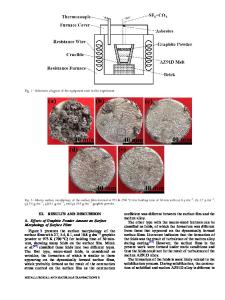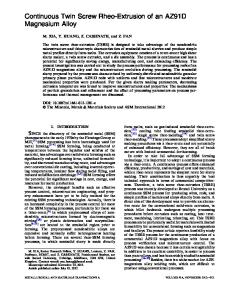Surface alloying of AZ91D alloy by diffusion coating
- PDF / 156,196 Bytes
- 3 Pages / 612 x 792 pts (letter) Page_size
- 54 Downloads / 252 Views
Surface alloying of AZ91D alloy by diffusion coating M-X. Zhang and P.M. Kelly Department of Mining, Minerals and Materials Engineering, University of Queensland, St. Lucia, Brisbane, QLD 4072, Australia (Received 19 May 2002; accepted 11 July 2002)
A new technique of surface modification by diffusion coating for AZ91D alloy was developed. A 1.0–2.0-mm alloy layer, which has hardness four to five times higher than the substrate metal, was formed after the treatment. Consequent solution treatment and aging could further improve the hardness of the alloy layer. Microstructure and chemical composition were investigated using optical microscope and electron probe. As the lightest metallic structural materials, magnesium alloys have very significant applications in the automotive and aerospace industries.1 However, low wear resistance and poor corrosion resistance of these alloys often limit their applications. Addition of various alloy elements, such as Zr, Ag, and a rare earth (RE), can improve the hardness and strength, but this increases the cost of the alloy. The AZ91 alloy is a widely used commercial Mg alloy, which has the features of good casting qualities1 and low cost. It suffers, however, from low harness and poor corrosion resistance in environments containing anions such as Cl−, CO32−, and SO42− with pH values less than 10.2 Hence, surface modification has been recognized as a major emergent technique for improving the surface properties—wear resistance and corrosion resistance. Most previous work3–5 has concentrated on surface alloying using laser or ion beams, which requires expensive facilities and, thus, increases the cost of components. In late 2000, Shigematsu et al.6 reported the results of diffusion coating of Mg alloy with Al. This technique only works for a Mg alloy that has been solution treated at 420 °C for 20 h. The surface-alloying treatment was carried out at 450 °C, which is higher than the eutectic temperature of Mg/Mg17Al12 (437 °C). Thus, surface cracks are observed within the alloy layer.6 The present work introduces a novel, reliable, and inexpensive surface-alloying technique for AZ91D alloy using a diffusion coating, which was originally developed for pure copper.7 The technique can significantly increase the surface hardness and also has the potential to improve the corrosion resistance. The alloy used is Mg–9 wt% Al–0.5 wt% Zn– 0.25 wt% Mn. As-cast 20 × 20 × 20 mm alloy blocks were placed in a small crucible and surrounded with an alloy powder mixture of 70 wt% Al and 30 wt% Zn. This filled up to two-thirds of the crucible. This was topped J. Mater. Res., Vol. 17, No. 10, Oct 2002
http://journals.cambridge.org
Downloaded: 16 Mar 2015
with a mixture of foundry sand and coke, which efficiently reduces oxidation of the underlying powder and the alloy block. The diffusion coating process was carried out at 430 °C for 12 h. Subsequently, the assembly was cooled to room temperature in air. A subsequent heat treatment, aimed at further improving the hardness of the alloy layer, involv
Data Loading...











